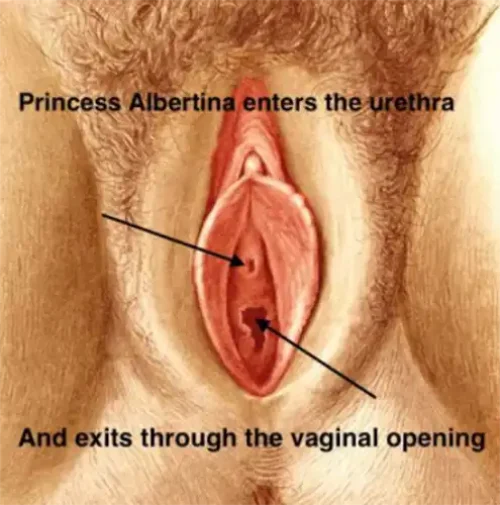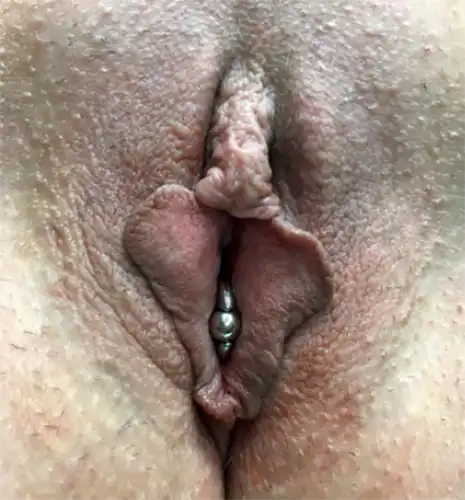Princess Albertina Piercing in Nairobi, Kenya
A Princess Albertina piercing is a type of female genital piercing. It is named after the male Prince Albert piercing but adapted for female anatomy. The piercing typically involves a ring or barbell inserted through the urethra and exiting through the vaginal opening. This piercing can enhance sexual pleasure for some individuals and is also chosen for its aesthetic appeal.

Princess Albertina Piercing
Princess Albertina Piercing Procedure
The Princess Albertina piercing is a complex and sensitive procedure, and it must be done by a highly experienced professional. Here is an outline of the steps typically involved in the procedure:
- Consultation: Before the actual piercing, you will have a consultation with one of our piercer. They will explain the procedure, discuss your medical history, and ensure you understand the risks and aftercare requirements.
- Preparation:
– Our piercer will clean and disinfect the genital area thoroughly.
– They will wear sterile gloves and use sterilized equipment to prevent infection.
– The appropriate jewelry (usually a ring or a barbell) will be selected, typically made of surgical steel or titanium to minimize allergic reactions. - Marking:
– Our piercer will mark the entry and exit points of the piercing. For a Princess Albertina, this involves entering through the urethra and exiting through the vaginal opening.
– Precision is crucial for the correct placement to avoid complications. - Piercing:
– Our piercer may use a receiving tube to support the tissue and guide the needle accurately.
– A hollow needle is used to create the piercing. This is done quickly to minimize discomfort.
– Once the needle is through, the jewelry is inserted immediately - Post-Piercing Care:
– The area is cleaned again, and our piercer will provide detailed aftercare instructions.
– This includes guidance on cleaning the piercing with a saline solution, avoiding sexual activity and tight clothing during the healing period, and monitoring for signs of infection. - Aftercare:
– You will need to clean the piercing at least twice a day with a saline solution.
– Avoid touching the piercing with dirty hands.
– Refrain from sexual activity and avoid using any products that could irritate the piercing until it has healed completely, which can take several months. - Follow-Up:
– Schedule follow-up visits with our piercer to ensure the piercing is healing correctly.
– If you notice any signs of infection, such as excessive redness, swelling, discharge, or severe pain, contact your piercer or a healthcare professional immediately.
Important Considerations:
- This piercing can significantly impact your urination and sexual function during the healing period.
- There are higher risks of infection due to the piercing’s location near the urethra and vaginal opening.
- Proper hygiene and aftercare are critical to prevent complications.
Choosing an experienced and reputable piercer and adhering to their aftercare instructions will help ensure the best possible outcome for a Princess Albertina piercing.
Considerations before getting a Princess Albertina Piercing
Before deciding to get a Princess Albertina piercing, it’s important to consider several factors to ensure you’re making an informed decision and are prepared for the procedure and its aftermath. Here are key considerations:
- Professional Expertise: At Rebel Inks Tattoos, Tattoo Removal, and Body Piercings Parlour we have a team of highly experienced and reputable piercers who specializes in genital piercings. View our credentials and look through our reviews and testimonials from previous clients.
- Anatomy Suitability: Not everyone is anatomically suited for a Princess Albertina piercing. A consultation with one of our piercer will help determine if this piercing is appropriate for your anatomy.
- Pain Tolerance: This piercing can be quite painful due to the sensitive nature of the tissue involved. Assess your own pain tolerance and readiness to undergo the procedure.
- Healing Time and Process: The healing process can take several months. During this time, you’ll need to follow strict aftercare routines, which include cleaning the piercing site regularly and avoiding activities that could irritate or infect the piercing.
- Risk of Infection: The piercing passes through the urethra, which increases the risk of urinary tract infections (UTIs). It’s crucial to maintain excellent hygiene and monitor for any signs of infection.
- Impact on Daily Activities: Consider how the piercing will affect your daily activities, including urination, sexual activity, and exercise. You may need to make adjustments to your routines during the healing period.
- Jewelry Choices: Initial jewelry should be of high quality, such as surgical steel or titanium, to minimize the risk of allergic reactions. Discuss jewelry options with your piercer to ensure you’re getting the safest and most comfortable choice.
- Cost: Genital piercings can be more expensive than other types of piercings due to their complexity. Ensure you are aware of the total cost, including the procedure, jewelry, and any aftercare products.
- Potential Complications: Be aware of the potential complications, including migration or rejection of the jewelry, scarring, and possible changes in urination patterns.
- Aftercare Commitment: Successful healing requires a significant commitment to aftercare. This includes cleaning the piercing site with saline solution, avoiding irritants, and following any specific instructions from your piercer.
- Lifestyle and Privacy: Consider how this piercing fits with your lifestyle and your comfort level with discussing it with intimate partners or healthcare providers.
- Medical History: Discuss your medical history with the piercer, including any conditions that might affect healing, such as diabetes or a history of keloid scarring.
Carefully considering these factors and having an open discussion with one of our piercers, you can make a well-informed decision about whether a Princess Albertina piercing is right for you.
Pain and Healing of Princess Albertina Piercing
The Princess Albertina piercing, like any genital piercing, involves a degree of pain and a significant healing process. Here’s what you need to know about the pain and healing involved:
Pain
- During the Procedure:
– The pain experienced during the piercing procedure can be quite intense due to the sensitive nature of the tissues involved. The piercing passes through the urethra, which is a particularly sensitive area.
– Pain levels can vary widely from person to person. Some may experience sharp, intense pain, while others may find it more tolerable.
– The use of a hollow needle, which is standard practice, helps minimize tissue damage and pain. - Immediately After the Procedure:
– There will be some immediate soreness and discomfort following the procedure.
– Swelling and tenderness around the piercing site are common.
Healing
- Initial Healing Period:
– The initial healing period typically lasts a few weeks, during which the piercing will be most sensitive and prone to irritation and infection.
– During this time, you may experience some discomfort, particularly when urinating or during physical activities. - Overall Healing Time: Full healing can take several months, typically around 3 to 6 months, depending on individual healing rates and how well aftercare instructions are followed.
- Monitoring for Infection: Keep an eye out for signs of infection, such as excessive redness, swelling, pus-like discharge, or increased pain. If you notice any of these symptoms, contact your piercer or a healthcare professional immediately.
- Avoiding Irritants:
– Avoid submerging the piercing in bodies of water like pools, hot tubs, or lakes, as these can introduce bacteria.
– Be cautious with personal care products that may contain irritants, such as lotions, sprays, or scented soaps.
Pain Management
- Over-the-Counter Pain Relief: Non-steroidal anti-inflammatory drugs (NSAIDs) like ibuprofen can help manage pain and reduce swelling.
- Cold Compresses: Applying a clean, cold compress can help alleviate swelling and discomfort.
Every individual’s experience with pain and healing will vary, but following the aftercare instructions diligently and maintaining good hygiene will promote proper healing and minimize complications. If you have any concerns or experience severe symptoms, don’t hesitate to contact a healthcare professional.
Princess Albertina Piercing Aftercare
Proper aftercare is crucial for ensuring a successful healing process for a Princess Albertina piercing. Here are detailed aftercare instructions:
Cleaning
- Saline Solution:
– Clean the piercing at least twice daily with a saline solution. You can buy a pre-made sterile saline solution or make your own by dissolving 1/4 teaspoon of non-iodized sea salt in 8 ounces of warm distilled water.
– Use a clean cotton ball or gauze pad to apply the saline solution gently to the piercing site. Avoid using harsh soaps, hydrogen peroxide, or alcohol, as these can irritate the area. - Gentle Cleaning:
– Be very gentle when cleaning the piercing to avoid causing further irritation or injury.
– Ensure that any discharge or crust that forms around the jewelry is removed carefully during cleaning.
Hygiene
- Hand Hygiene: Always wash your hands thoroughly with soap and water before touching your piercing to prevent introducing bacteria to the area.
- Urination: After urinating, rinse the area with clean water to remove any residual urine, which can cause irritation.
Avoiding Irritants
- Clothing:
– Wear loose-fitting, breathable clothing and underwear to reduce friction and pressure on the piercing.
– Avoid tight jeans or leggings that can rub against the piercing. - Products:
– Avoid using scented soaps, lotions, or sprays around the piercing site. Stick to mild, unscented products.
– Refrain from using any products that contain alcohol or other harsh chemicals.
Sexual Activity
- Abstinence: Avoid sexual activity for at least 4 to 6 weeks or until the piercing is fully healed. Sexual activity can introduce bacteria and cause trauma to the piercing.
- Protection:
– Once you resume sexual activity, use condoms or dental dams to minimize contact and protect the piercing from potential infections.
– Ensure that both you and your partner maintain good hygiene before engaging in any sexual activity.
General Care
- Swimming and Bathing:
– Avoid swimming in pools, hot tubs, lakes, or other bodies of water during the initial healing period to prevent exposure to bacteria.
– Take showers instead of baths to keep the piercing as clean as possible. - Avoid Trauma: Be cautious with activities that might put pressure on the piercing, such as cycling, horseback riding, or other sports that involve direct contact with the genital area.
Monitoring Healing
- Watch for Signs of Infection: Be vigilant for signs of infection, including excessive redness, swelling, warmth, pus-like discharge, or severe pain. If you notice any of these symptoms, contact your piercer or a healthcare professional immediately.
- Follow-Up Visits: Schedule follow-up visits with your piercer to ensure that the piercing is healing correctly. Your piercer can provide additional guidance and address any concerns you may have.
Pain Management
- Over-the-Counter Pain Relief:
– You can take non-steroidal anti-inflammatory drugs like ibuprofen to help manage pain and reduce swelling.
– Applying a clean, cold compress can also help alleviate swelling and discomfort.
By adhering to these aftercare guidelines, you can help ensure a smooth and successful healing process for your Princess Albertina piercing. If you have any questions or encounter any issues during the healing period, don’t hesitate to reach out to our piercer for advice and support.
Princess Albertina Piercing Jewelry
Choosing the right jewelry for a Princess Albertina piercing is crucial for comfort, healing, and overall success of the piercing. Here are some important considerations regarding the jewelry:
Types of Jewelry
- Captive Bead Rings (CBRs):
– Description: A circular ring with a small bead that is held in place by the tension of the ring.
– Advantages: Captive bead rings are popular for initial piercings due to their ease of cleaning and relatively simple design.
– Considerations: Ensure the ring is of an appropriate size to accommodate any initial swelling and to avoid excessive movement that could irritate the piercing. - Curved Barbells:
– Description: A slightly curved bar with threaded balls on each end.
– Advantages: Curved barbells can reduce pressure on the piercing and are often more comfortable during the healing process.
– Considerations: The curve should be gentle enough to follow the natural shape of the piercing without causing stress on the entry and exit points.
Material Choices
- Surgical Stainless Steel:
– Pros: Affordable, durable, and widely available. Suitable for most people.
– Cons: Some individuals may have sensitivities to the nickel content in stainless steel. - Titanium:
– Pros: Hypoallergenic, lightweight, and strong. An excellent choice for those with metal sensitivities.
– Cons: More expensive than stainless steel. - Niobium:
– Pros: Hypoallergenic and flexible. A good alternative for those with metal allergies.
– Cons: Less common and can be more expensive. - Gold:
– Pros: Hypoallergenic (if high-quality, 14k or higher), and many find it aesthetically pleasing.
– Cons: Expensive and softer than other metals, which can be less durable.
Sizing and Fit
- Gauge (Thickness): Standard gauges for Princess Albertina piercings range from 6g, 10g, 12g, or 14g. Thicker gauges are generally more stable but may require more time to heal.
- Diameter (For Rings): The diameter of a captive bead ring should be large enough to allow for initial swelling but not so large that it moves excessively. Your piercer will recommend the appropriate size based on your anatomy.
- Length (For Barbells): Curved barbells should be long enough to accommodate swelling but not so long that they cause unnecessary movement or irritation.
Initial Jewelry
- Choosing the Right Initial Jewelry:
– The initial jewelry should prioritize healing. This means selecting hypoallergenic materials and appropriate sizes to accommodate swelling.
– Our piercer will measure and fit the jewelry to ensure it sits correctly and comfortably.
Long-Term Jewelry
- Switching Jewelry:
– Once the piercing is fully healed, you can switch to different styles or materials if desired. Always ensure that any new jewelry is clean and sterile.
– Consult with our piercer before changing jewelry to ensure it is safe to do so.
Maintenance
- Regular Cleaning: Even after healing, continue to clean your jewelry regularly to prevent buildup of bacteria or debris.
- Check for Wear and Tear: Inspect your jewelry for any signs of damage or wear, such as rough edges or loose beads, which could irritate the piercing.
By selecting the right type, material, and size of jewelry, and following proper care guidelines, you can ensure a comfortable and successful healing process for your Princess Albertina piercing. Always follow your piercer’s recommendations and seek their advice if you have any concerns about your jewelry or piercing.
Cost of a Princess Albertina Piercing in Nairobi, Kenya
The cost of a Princess Albertina piercing can vary significantly depending on several factors, including the location of the piercing studio, the experience and reputation of the piercer, the type of jewelry used, and any additional services or aftercare products provided. Here are some key points to consider when estimating the cost:
Factors Influencing Cost
- Location:
– Geographic Location: Piercing prices can vary based on the cost of living in different regions. Major cities and areas with higher living costs tend to have higher prices.
– Studio Location: Piercing studios in different areas may have varying price ranges. Rebel Inks Tattoos, Tattoo Removal, and Body Piercings Parlour is located in the heart of the Central Business Disrict (CBD) in Nairobi, Kenya, and is easily accessible to both locals and foreigners in the country - Experience and Reputation of the Piercer:
– Expertise: More experienced and reputable piercers often charge higher fees due to their skill and the quality of service they provide.
– Reviews and Reputation: Studios with strong reputations and positive reviews may have higher prices reflecting their established trust and quality. - Type and Quality of Jewelry:
– Material: Jewelry made from high-quality materials such as titanium, niobium, or 14k gold is more expensive than stainless steel.
– Design: Custom or intricate jewelry designs can also increase the overall cost. - Additional Services:
– Consultation Fees: Some studios may charge a separate fee for an initial consultation, especially if it involves detailed discussion about the piercing process, aftercare, and suitability.
– Aftercare Products: Studios may offer aftercare products like saline solutions, which can add to the total cost. - Follow-Up Visits: Check-Ups: Some studios include follow-up visits in the initial cost, while others may charge separately for check-ups or additional consultations.
At Rebel Inks Tattoos, Tattoo Removal, and Body Piercings Parlour our piercers may offer additional services or perks as part of the piercing package, such as consultation fees, aftercare products, or follow-up appointments. These services can impact the overall cost of the piercing experience.
Princess Albertina Piercing Estimated Cost Table
Component / Package | Estimated Cost (KSh) | Notes / Context |
Procedure + standard titanium jewelry | 5,000 – 8,000 | Based on pricing of similarly advanced genital piercings |
Premium jewelry upgrade (gold/custom) | 1,500 – 3,000 | Optional aesthetic/ hypoallergenic upgrades |
Aftercare kit & post-procedure follow-u | 500 – 1,500 | Critical for hygiene and healing |
Total – Basic Package | 5,000 – 8,000 | Core service with essential jewelry |
Total – Full-Service Packag | 7,000 – 12,000 | With upgrades and full aftercare support |
Tips for Cost Management
- Research and Compare: Look at multiple studios to compare prices and services. Make sure to consider the piercer’s experience and reviews rather than just the price.
- Ask for Detailed Quotes: Get a detailed quote that breaks down the costs for the procedure, jewelry, and any additional services or products.
- Inquire About Package Deals: At Rebel Inks Tattoos, Tattoo Removal, and Body Piercings Parlour we may offer package deals that include aftercare products and follow-up visits, Contact Us for inquiries
- Prioritize Quality: While it might be tempting to opt for a cheaper option, prioritize the quality of the piercer and the materials used to ensure the best outcome and minimize the risk of complications.
The cost is an important consideration, but the quality and safety of the procedure should always come first. Investing in a reputable piercer and high-quality jewelry can make a significant difference in your overall experience and the healing process.

Possible side effects of Princess Albertina Piercing
Getting a Princess Albertina piercing, like any body modification, comes with potential side effects and risks. It’s important to be aware of these before deciding to proceed with the piercing. Here are the possible side effects and complications:
Common Side Effects
- Pain and Discomfort: Pain during and after the procedure is common. The initial pain typically subsides within a few days, but some discomfort may persist during the healing process.
- Swelling: Swelling around the piercing site is normal, especially in the first few days. Using a cold compress can help reduce swelling.
- Bruising: Bruising may occur around the pierced area. This should fade as the piercing heals.
Potential Complications
- Infection:
– The risk of infection is higher with genital piercings due to the moist environment and proximity to bacteria.
– Signs of infection include excessive redness, warmth, swelling, pain, and discharge (yellow or green pus). Prompt treatment is essential if an infection occurs. - Urinary Tract Infection (UTI): Since the piercing involves the urethra, there is an increased risk of developing a UTI. Symptoms include frequent urination, burning sensation during urination, and cloudy or strong-smelling urine.
- Migration and Rejection: The body may recognize the jewelry as a foreign object and push it out, causing migration or rejection. This can lead to scarring and an uneven piercing site.
- Scarring: Hypertrophic scars or keloids can develop at the piercing site. Some people are more prone to scarring than others.
- Allergic Reactions: Allergic reactions to the jewelry material can cause itching, redness, and swelling. Using hypoallergenic materials like titanium or niobium can reduce this risk.
- Bleeding: Some bleeding is normal immediately after the piercing, but excessive or prolonged bleeding may indicate a problem and should be checked by a professional.
Long-Term Considerations
- Changes in Urination: The piercing may temporarily affect urination patterns, causing changes in the direction or flow of urine. This usually normalizes as the piercing heals.
- Sexual Activity: Sexual activity should be avoided during the initial healing period to prevent irritation and infection. Once healed, the piercing can enhance sexual pleasure for some, but it may also cause discomfort or require adjustments in sexual practices.
- Sensitivity and Discomfort: Increased sensitivity in the pierced area can be a double-edged sword, leading to both enhanced pleasure and potential discomfort during certain activities.
- Jewelry Complications: Incorrectly fitted or poor-quality jewelry can cause irritation, embedding, or injury to the tissue. Regular checks and proper jewelry maintenance are essential.
Prevention and Management
- Choose a Reputable Piercer: Selecting a professional, experienced piercer reduces the risk of complications.
- Follow Aftercare Instructions: Adhering to proper aftercare routines, including regular cleaning and avoiding irritants, is crucial for healing.
- Use Hypoallergenic Jewelry: Initially use high-quality, hypoallergenic materials to minimize allergic reactions and irritation.
- Monitor for Signs of Infection: Be vigilant about changes in the piercing site and seek prompt medical attention if you notice signs of infection or other complications.
- Consult Your Piercer: Maintain regular follow-ups with your piercer to monitor healing and address any concerns.
By being aware of these potential side effects and taking steps to mitigate them, you can ensure a safer and more successful healing process for your Princess Albertina piercing.
Related Piercing
Get In Touch
For more information on the list above and any other special services,please call or come in for free consultation
Testimonials
After he pierced my industrial piercing and seeing his amazing work, I feel even more excited about getting my tattoo with him in January. I’m really looking forward to it!
I am extremely happy with my new 'Safari' tattoo from Eric at Rebel Inks! The quality of the artwork is fantastic. Eric is a true professional and an amazing artist.
The preparation and design process was thorough and collaborative. He was very patient with my specific requests, including making sure all the elements, which hold personal meaning, were perfect.
The service was friendly and highly professional from start to finish. Despite the 8-hour session, Eric was a pleasant person to spend the time with.
The aftercare guidance and follow-up have been excellent and careful, which has made the healing process easy and better than expected.
I highly recommend Eric for anyone looking for a thoughtful, talented, and caring tattoo artist.
I recommend them 💯
I would definitely recommend if you’re thinking of getting a piercing!
The staff were super friendly, explained everything clearly, and made me feel so at ease. They answered all my nervous questions (and I had many questions),
They walked me through the whole process, gave detailed aftercare instructions, and even followed up afterward to check how I was healing 🫶
Clean, professional, and full of good vibes.
Would 100% recommend . Definitely making a second trip here.
This was the second tattoo I got and I wish I could have come to Eric for my first one! He gave me really great after-care directions for the tattoo as well as a little jar of his own Vaseline-type stuff to put over my tattoo while it was healing! He even put second skin over my tattoo so that I didn’t have to worry about it for the first few days. Now THAT’S good service. My first tattoo artist didn’t do none of that lol.
After the session Eric didn’t rush me and my friend out, he chatted with us and even when he found out I was an artist too— really encouraged me to keep creating and to find a community of artists to support me. I almost cried because I’ve had such a hard time with my own art the past couple of years, it meant so much to me to have a fellow very talented artist say that to me. 🤍🤍🤍
Eric you’re amazing, don’t ever stop creating and just know you’ve impacted lives all over the world!🫶🏻 thanks so much for everything!!
From the moment I walked in, Eric was professional, welcoming, and attentive. He made sure I was comfortable throughout, provided everything I needed, and explained every step of the process. The tattooing itself was unbelievably smooth - I genuinely felt no pain compared to my previous tattoos over the last 22 years.
Eric also gave me excellent aftercare guidance and products, and thanks to that, my tattoo healed beautifully. The attention to detail, precision, and shading are absolutely stunning. This is hands-down the best tattoo I've ever had, and I will be flying back to Nairobi for any future ink.
If you want incredible art, a professional experience, and a talented artist who truly cares about his clients, Rebel Ink is the place to go!
From start to finish, the service was exceptional. The piercer was professional, knowledgeable, and made me feel completely comfortable. The cleanliness of the place was above and beyond — everything was spotless and hygienic, which really put me at ease. Highly recommend for anyone considering a piercing!
Shout out to Eric😘
We ended up changing the jewelry three times to ensure I had the best fit and avoided any signs of rejection, and he always listened to my suggestions as a client, which I really appreciated. Now, three months in, my piercing is healing beautifully, with no sign of rejection. Highly recommend for anyone who values a piercer who cares about your comfort and healing journey!
What stood out the most was the aftercare Eric checked in with me even three weeks later to see how the tattoo was healing. That kind of follow-up shows how much he truly cares about his work and his clients.
I’m very satisfied and will definitely be coming back for my next piece. Highly recommend!
The piercing wasn't as painful as I had thought and the process was quick and satisfactory. I love it!!!
The piercing is healing well thanks to the aftercare instructions and follow-up. I would highly recommend Rebel Inks
Eric also did a belly button piercing for a friend, guiding her through the process, doing the piercing and then explaining the after care to her.
The shop is on the 3rd floor, with the entrance to the stairs near an alleyway on the left. The shop is perfect size, clean, and attractive looking. The mural is pretty dope.
Thank you for the amazing service! 🔥👅✨
I got piercibgs there and the process was really good. My biggest concern was hygiene but that wasn't an issue at all, they use new needles and they sanitize them.
The service itself was also welcoming.
I was informes of everything i needed to know beforehand.
10/10 would recommend!
Eric was so calm and patient with my almost 2 year old lady. It was such a clean and hygienic process. We will definitely be back for our second rounds of piercings and maybe even another tattoo!
They assess the area before any art and advise one accordingly. They also give one post clean up process and also do a check up after the body art projects. Overall, I loved my experience and I’m hooked. 👍
Will definitely come back next time I’m in town 🙂
He listened to what I actually wanted and made sure he could fit in the time before I flew back home.
The shop is clean & private and is easy enough to find.
Eric has even checked in a couple of times since to make sure all is good.
I would totally recommend Eric! I absolutely love my Elephants!
I had a very easy healing period and always follow up from Eric to check on my progress...I would highly recommend if you are a first timer because from my experience all went very well and attention to detail
Thank you for a good job and looking forward to send all my friends your way
And all the best with the new year 2025!
From the moment I walked in, the staff was super friendly and made me feel at ease. The studio had a clean, professional atmosphere, which immediately put me at ease. My piercer was incredibly skilled and explained every step of the process, ensuring I was comfortable the entire time. The piercing was quick and practically painless, and the aftercare instructions were clear and easy to follow. I can tell they really care about the health and safety of their clients.
Overall, a fantastic experience—I highly recommend Rebel Inks and Tattoos for anyone looking to get pierced or tattooed!
They do follow up after their services
Eric's Studio isn’t just a place to get a tattoo—it’s an experience. The combination of professionalism, artistic talent, and a welcoming environment makes it a standout destination for anyone considering a tattoo.
I highly recommend Eric’s Studio to both first-timers and seasoned tattoo enthusiasts. If you’re looking for a high-quality tattoo and an enjoyable experience, this is the place to go.
I would definitely recommend their services again and again
Thank you Rebel Ink
My piercings are healing ❤️🩹 well
I would 💯 recommend
I will definitely come back for more .
Two, all the equipments he used for the piercings were new and/or sterilised.
Three, the parlour itself was very clean and was up to par with the hygiene standards.
Four, Eric provided effective aftercare instructions, making sure I knew exactly how to take care of my new piercings and he kept in touch and continues to do so, to check on the healing progress.
I highly highly highly recommend this place!!!
Would definitely recommend them to friends and go back for other piercings
Not only was the piercing process smooth, but he also provided thorough aftercare instructions, making sure I knew exactly how to take care of my new piercings. What really impressed me was that he keeps in touch to check on how the healing is progressing – a sign of true care for his clients.
The shop maintains a high standard of hygiene, and the atmosphere is welcoming and comfortable, which really added to the positive experience. I highly recommend this place to anyone looking for a professional and caring experience. I’ll definitely be coming back for any future piercings!
My appreciation for the excellent customer service I received. The follow-ups were prompt, and I truly appreciated the gentleness and professionalism throughout. Thank you!"
"Looking for professional eyebrow microshading removal? Look no further!"
The customer care is top tier 👌🏾👌🏾.
Wonderful place to get tattoos and piercings. 💯💯
Eric goes ahead to follow up on his clients progress and gives good advice each time I reach out to him.
I would recommend Reble tattoos anytime.
Good job bro we really appreciate.
Ohh and the price is very fair.
The environment was clean , procedure was sterile and the jewelry used are of the best quality.
He followed up with me during the healing process, he educated me on what I needed to do for my aftercare.
Eric is confident, skilled , experienced and the best piercer. Highly recommend Rebel inks.✨
Definitely recommend!
Great experience.
Eric definitely know what he is doing .
I got exactly what I wanted 2 tiny tats on the same finger .
He was kind and patient throughout the session.
Healing process has been good .
Aftercare services were given and regular checkups on the healing process were done.
I would 💯recommend.
Eric gave me the best reception as it was my first time there,and made me trust him all the way. I appreciate good services.
There services are also affordable not to forget 😊.
He was also invested in the aftercare and would ensure I follow the do's and don'ts in taking care of the tattoo and ensuring proper healing and maximum ink retention.
Would highly recommend Rebel Inks Tattoos.
Rebel Inks Tattoo offer the best,affordable and quality tattoo removal services.If you have unwanted ink,choose Rebel Inks Tattoo,they're the best of the best and the professionalism is a top notch.They ensure you're free from unwanted ink with their Laser Tattoo Removal Technology...
I did a Laser Tattoo Removal with them and i can attest they're the best....
Kudos Eric...
I highly recommend.
It was a generally good experience with good hygiene during the piercing process and has been a smooth healing process.... 10/10
tips. Highly recommend 👍🏽
100% recommendable.
I was particularly impressed with Eric's attention to hygiene. He thoroughly cleaned the room before I entered, sanitized all of the equipment he would be using, and changed gloves between each ear. This level of cleanliness gave me great confidence in his professionalism.
Eric's commitment to customer service did not end on the day of the piercing. He followed up with me regularly throughout the healing process to ensure that I was following the aftercare instructions and that my earlobes were healing properly.
I highly recommend Rebel Inks to anyone in Nairobi who is considering getting a piercing. Eric is a highly skilled and experienced piercer who takes great pride in his work.
So I Check all the boxes below and more:
Customer Care: ✔️
Professionalism : ✔️
Cleanliness ✔️
Price: ✔️
After care service ✔️
Thanks and good job, Eric
The place is neat and clean and the equipments he used were also fine standards. Really appreciate his following up with me on the healing 🤗
I WOULD HIGHLY RECOMMEND THEIR SERVICES to everyone. Actually what you see on their website is EXACTLY what you will get. Keep up the good work Rebel inks Tattoos.
The infection is now gone. I would definitely recommend!
Can recommend this place totally and would go back there anytime!
Thanks!
OUR LOCATION
Areas We Serve
NAIROBI
KIAMBU
KAJIADO
MACHAKOS
















































































































































































































